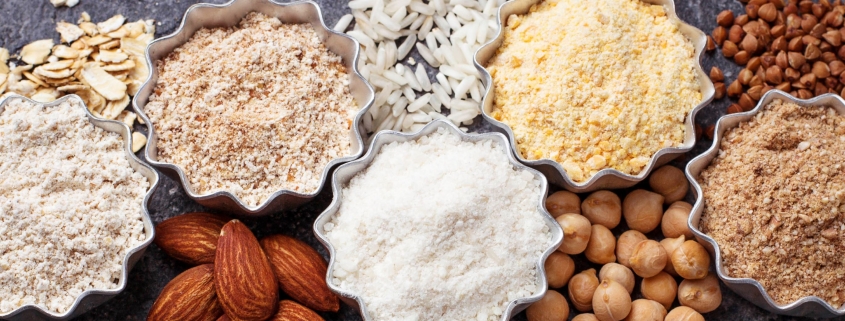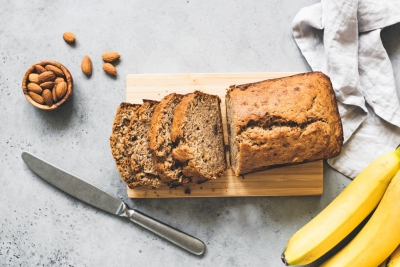Start Baking with These Top Alternative Flours

Baked goods are a quintessential part of many celebrations. Whether you’re crafting a pecan or mince pie, babka, noodles, or the family’s secret recipe for soft rolls, most list flour as a main ingredient. This year, give your traditional recipes a tasty transformation by swapping for one of the top alternative flours.
When mixing up your favorite batter, flour serves as a binding agent to help hold your mixture together and add texture and flavor. Regular flour is made from ground whole-wheat kernels. Whole grains are nutritious, but as they’re processed down into heavily refined white flour, many of the beneficial ingredients are stripped away and its glycemic impact raises.
This is where alternative flours come in. These flour substitutes have gained popularity over the last several years, and for good reason. You can enjoy the same textures and cohesion as regular flour, but with a lower glycemic impact, more flavor, and a multitude of nutritional benefits.
What is an Alternative Flour?
Alternative flours are commonly made from nuts, seeds, beans, and other grains. Like regular flour, the whole ingredients are processed and milled into a semi-fine powder. Many, like chickpea and almond flour, offer similar binding properties. This makes the flour substitutes an easy 1:1 replacements in your go-to recipes—though some master bakers recommend a pinch more baking powder to offset almond flour’s slightly heavier weight.
Because they often contain more vitamins, minerals, and phytonutrients than regular flour, alternative flours fit perfectly into popular dietary guidelines—ketogenic, paleo, low-carb, gluten-free, or wheat-free diets. Even if you aren’t focused on a specific eating plan, the added variety and additional fiber work wonders for your gut health.
Comparing White, Whole Wheat, and Almond Flours
To understand the health benefits of alternative flours, let’s first look at the average nutritional values of the two most common grain flours: white and whole wheat.
Unbleached White Flour, 1 cup (227 g)
- 455 calories
- 4 g carbs
- 4 g dietary fiber
- 9 g protein
- 2 g fat
- 2 g saturated fat
- 6 g poly and monounsaturated fat
- Glycemic load: 85
Although white flour is a good source of thiamin, folate, and selenium, the glycemic load of 85 is high. A healthy number to aim for is 55 or less. Additionally, white flour is stripped of its nutrients during the production process, and then added back later.
Whole-grain Wheat Flour, 1 cup (227 g)
- 407 calories
- 1 g carbs
- 6 g dietary fiber
- 16 g protein
- 2 g fat
- 4 g saturated fat
- 2 g poly and monounsaturated fat
- Glycemic load: 69
Like white flour, whole-grain wheat flour is a good source of thiamin, folate, and selenium. It has fewer total carbs, and a whopping 14.6 grams of dietary fiber to help your body respond to all you’ll throw at it during celebrations.
Cup-for-cup, whole-grain wheat flour is the clear winner over the unbleached white variety. Now, let’s see how almond flour stacks up.
Almond Flour, 1 cup (227 g)
- 648 calories
- 24 g protein
- 24 g carbs
- 14 g dietary fiber
- 56 g fat
- 3 g saturated fat
- 7 g poly and monounsaturated fat
- Glycemic Load: less than 1
While higher in calories than white or wheat, almond flour has almost no effect on blood sugar—and it’s full of healthy, monounsaturated fats and prebiotic, insoluble fiber. Insoluble fiber is an essential carbohydrate that makes you feel fuller, longer to help you maintain a healthy weight. And it supports good digestive health by feeding your gut bacteria.
Almond flour is a good source of a variety of phytonutrients, such as resveratrol and flavonoids, and it’s rich in vitamin E and other antioxidants. It also provides other essential minerals like calcium, iron, and manganese.
When it comes to cooking, almond flour has a light, buttery flavor that blends well with savory or sweet baking. Because its binding properties are similar to regular flour, it substitutes at a 1:1 ratio. With an abundance of healthy benefits and its ease to swap it in recipes, almond flour is one of the best and most popular alternative baking and bread flours.
Flavorful Flour Substitutes
Now you know the nutritional baseline of white, wheat, and almond flours, you can compare other alternative flours. Here are the average nutrition facts for some of the most popular flour substitutes on the market.
Buckwheat Flour, 1 cup (227 g)
- 560 calories
- 16 g protein
- 115 g carbs
- 36 g dietary fiber
- Less than 1 g fat
- 0 g saturated fat
- Glycemic Load: 71
Contrary to the name, buckwheat flour contains no wheat, and is gluten free. While it has the highest glycemic impact of any flour on this list, buckwheat is rich in fiber, antioxidants, and micronutrients like folate, iron, magnesium, manganese, and zinc.
Buckwheat flour has a strong, earthy flavor that’s ideal for muffins, tarts, and banana bread. It doesn’t bind well, so either find recipes specifically made for buckwheat flour, or mix it with other alternative flours to avoid crumbly baked goods.
Cassava Flour, 1 cup (227 g)
- 460 calories
- Less than 1 g protein
- 28 g carbs
- 8 g dietary fiber
- Less than 1 g fat
- 0 g saturated fat
- Glycemic Load: 46
This flour is made from cassava root, and even though it’s generally low in nutrients, cassava flour contains vitamin C, folate, thiamine, and essential minerals like manganese and potassium.
Cassava is a popular alternative flour. Known for its neutral flavor and powdery texture, it’s commonly a 1:1 replacement for white flour. It tends to be a bit more absorbent, so bakers recommend using slightly less than an equal ratio compared to white flour. This will help maintain moisture in grandma’s famous cookie recipe.
Chickpea Flour, 1 cup (227 g)
- 356 calories
- 20 g protein
- 53 g carbs
- 10 g dietary fiber
- 6 g fat
- 6 g saturated fat
- Glycemic Load: 44
Chickpeas are the main ingredient in hummus, and they also make for a tasty and healthy alternative flour. Relatively low in fat, with almost no saturated fat, chickpea flour has a medium-low glycemic index of 44. It’s also a fantastic source of folate—over 100 percent of your daily recommendation. It also gives you thiamine and minerals like iron, magnesium, and manganese.
Like almond flour, chickpea flour has a natural, light nutty flavor that’s ideal for many baked goods, but with stronger binding properties. You won’t regret swapping in this flour in your next batch of tortillas.
Coconut Flour, 1 cup (227 g)
- 480 calories
- 6 g protein
- 72 g carbs
- 40 g dietary fiber
- 16 g fat
- 13 g saturated fat
- Glycemic Load: 50s
Coconut flour is low in fat and packed with dietary fiber and medium-chain triglycerides (MCT). Derived from coconut oil, these triglycerides help deliver vital nutrients, such as vitamin E and Coenzyme Q10, to support your brain and heart health.
Coconut flour has a mildly sweet taste, which may affect the flavor profile of your cooking. Its binding properties aren’t a match for regular flour, as it absorbs more liquid. Mix with other flours, add an egg for additional moisture, or find recipes specifying coconut flour as an ingredient.
Oat Flour, 1 cup (227 g)
- 420 calories
- 15 g protein
- 68 g carbs
- 8 g dietary fiber
- 5 g fat
- 7 g saturated fat
- Glycemic Load: 44
Oats make a great dairy-free milk, and they are just as good as a gluten-free flour substitute. Oat flour contains healthy fats, dietary fiber, antioxidants, thiamin, and iron. While not necessarily a nutritional superfood, it has a mild taste, binds well, and is easy to make at home with whole oats and a blender or food processor. If you’re looking to replace white flour on a budget, this could be your new go to.
Quinoa Flour, 1 cup (227 g)
- 440 calories
- 16 g protein
- 72 g carbs
- 8 g dietary fiber
- 2 g fat
- 0 g saturated fat
- Glycemic Load: 53
While higher in carbs and glycemic impact compared to other alternative flours, quinoa is a nutritious grain full of phytonutrients. It’s also packed with B vitamins, calcium, vitamin E, iron, magnesium, potassium, and antioxidants.
Quinoa flour has an earthy, lightly bitter flavor and pairs well with spices. Like coconut flour, it absorbs more moisture when binding. Try it in your batch of gingerbread or tall stack of pancakes.
Elevate Your Baking Experience
When it comes to home cooking, there’s always an alternative flour fit for the job. Popular substitutes like almond and chickpea flour make for simple 1:1 swaps in any recipe, and are great to help you cater to the diets of your family and guests.
Use the information you just learned to choose the flour that’s right for you and your menu. Everyone at the table will enjoy your tasty twist on more satisfying, and nutritious, celebratory favorites.
References
https://celiac.org/gluten-free-living/what-is-gluten/
https://healthyeating.sfgate.com/healthy-wholewheat-flour-vs-white-3305.html
https://onlinelibrary.wiley.com/doi/abs/10.1111/j.1365-277X.2009.00970.x
https://www.tandfonline.com/doi/abs/10.1080/15428052.2014.952475
https://www.afsuter.com/application/binding-agents/
https://nutritiondata.self.com/













